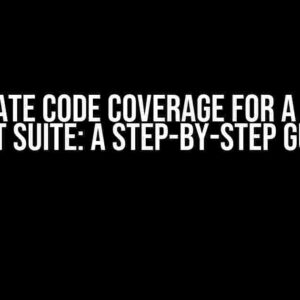Are you tired of playing catch-up with the latest Android updates? With the rapid pace of innovation in the mobile world, it’s essential to stay ahead of the curve. That’s why Google has raised the bar, and now, your app must target Android 14 (API level 34) or later. In this comprehensive guide, we’ll explore the benefits, requirements, and step-by-step instructions to help you make the transition seamlessly.
What’s the Big Deal About Android 14 (API Level 34)?
Android 14 (API level 34) marks a significant milestone in Android’s evolution. This update brings forth a plethora of features, security enhancements, and performance improvements that will revolutionize the way you build and deploy your apps. Some of the key highlights include:
- Improved Performance**: Android 14 (API level 34) introduces a new runtime, ART (Android Runtime), which provides faster performance, improved memory management, and enhanced security.
- Enhanced Security**: This update includes robust security features, such as improved biometric authentication, enhanced encryption, and better protection against malicious apps.
- Modular Architecture**: Android 14 (API level 34) adopts a modular architecture, allowing for more flexible and efficient updates, making it easier to maintain and optimize your app.
Why Must Your App Target Android 14 (API Level 34) or Later?
Google has made it clear that, starting from November 2023, new apps submitted to the Google Play Store must target Android 14 (API level 34) or later. But why is this mandatory, you ask? Here are a few compelling reasons:
- Future-Proofing**: By targeting Android 14 (API level 34) or later, you ensure your app remains compatible with upcoming Android versions, reducing the risk of compatibility issues and minimizing the need for frequent updates.
- Security and Stability**: Android 14 (API level 34) provides cutting-edge security features, protecting your users’ data and ensuring a more stable app experience.
- Competitive Advantage**: By adopting the latest Android version, you demonstrate your commitment to innovation, setting your app apart from the competition and increasing its appeal to users.
Step-by-Step Guide to Targeting Android 14 (API Level 34) or Later
Now that you understand the importance of targeting Android 14 (API level 34) or later, let’s dive into the practical steps to make this transition:
Step 1: Update Your Android Studio
To start, ensure you’re running the latest version of Android Studio. You can check for updates by following these steps:
Go to Help > Check for Update (Windows/Linux) or Android Studio > Check for Updates (Mac)
Step 2: Configure Your Project
Next, update your project to target Android 14 (API level 34) or later by modifying the build.gradle file:
android {
compileSdkVersion 34
...
}
Step 3: Update Your App’s Target SDK Version
In your app’s AndroidManifest.xml file, update the targetSdkVersion attribute to 34 or later:
<uses-sdk android:targetSdkVersion="34" />
Step 4: Test Your App
Thoroughly test your app to ensure it’s compatible with Android 14 (API level 34) or later. Focus on testing:
- App performance and stability
- Security features, such as biometric authentication and encryption
- Modular architecture and its impact on your app’s functionality
Troubleshooting Common Issues
During the transition, you might encounter some common issues. Here are some troubleshooting tips:
| Issue | Solution |
|---|---|
| App crashes or fails to launch | Check for compatibility issues with third-party libraries or SDKs. Update them to the latest versions. |
| Performance issues or slowdowns | Optimize your app’s code, focus on efficient memory management, and leverage ART’s performance enhancements. |
| Security warnings or errors | Review your app’s security implementation, ensuring it adheres to Android 14’s enhanced security features and guidelines. |
Conclusion
By targeting Android 14 (API level 34) or later, you’re not only future-proofing your app but also providing a more secure, stable, and efficient experience for your users. Follow the instructions outlined in this guide, and you’ll be well on your way to creating an app that shines on the latest Android versions.
Remember, the Android ecosystem is constantly evolving, and staying ahead of the curve is crucial for success. So, take the leap and make the transition to Android 14 (API level 34) or later today!
Happy coding!
- Additional Resources:
This article has provided a comprehensive guide to help you understand the benefits, requirements, and step-by-step instructions to target Android 14 (API level 34) or later. By following these guidelines, you’ll ensure your app remains competitive, secure, and future-proof, providing an exceptional user experience on the latest Android versions.
Frequently Asked Question
The world of Android app development is ever-evolving, and with new versions come new requirements. If you’re scratching your head over the “App must target Android 14 (API level 34) or later” notification, we’ve got you covered!
What does it mean when an app must target Android 14 (API level 34) or later?
It means that the app must be built to be compatible with the latest Android operating system, Android 14, which has a corresponding API level of 34. This ensures that the app takes advantage of the new features, security patches, and performance enhancements offered by the latest Android version.
Why is targeting a specific API level necessary?
Targeting a specific API level ensures that the app is compatible with the intended Android version, which in turn ensures that the app works as intended, is secure, and provides the best user experience. It also helps Google Play Store to filter out incompatible apps and prevent users from installing apps that may not work properly on their devices.
Will my app still work on older Android versions if I target Android 14 (API level 34)?
Yes, targeting Android 14 (API level 34) doesn’t mean your app won’t work on older Android versions. You can still set a minimum API level (minSdkVersion) to ensure your app is compatible with older devices, while taking advantage of the latest features on newer devices.
What happens if I don’t update my app to target Android 14 (API level 34)?
If you don’t update your app, it may not be available for users with Android 14 devices, and you might miss out on the latest features, security patches, and performance enhancements. Additionally, Google Play Store might eventually stop allowing updates to your app if it doesn’t meet the minimum API level requirements.
How do I update my app to target Android 14 (API level 34)?
You can update your app’s target API level by modifying the `android:targetSdkVersion` attribute in the `AndroidManifest.xml` file. You’ll also need to ensure your app is compatible with the new Android 14 features and APIs. You can find more information on the Android Developer website.



